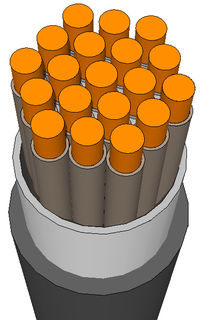High frequency stranded wire
High-frequency litz wire , also known as HF litz wire , is a litz wire that consists of a large number of fine wires , usually insulated from one another by varnish , which are intertwined in such a way that, on average, each individual wire takes up every point in the total cross-section of the wire as often as possible. This strand is used in high frequency technology.
description
The higher quality in the high-frequency range is based on the increase in the cross-section effectively involved in the flow of current, which is limited in the case of solid wire due to the following effects:
- Skin effect (charge carrier displacement due to the magnetic field of the individual conductor). At high frequencies, due to this effect, most of the current flows along or near the surface of the conductor. For example, at a frequency of 10 MHz, the current density 20 µm below the surface is only 1 / e-th part (37%) of the current density on the outermost surface. By increasing the conductivity, especially of the surface, the loss resistance can be reduced.
- Proximity effect (current displacement between two closely spaced conductors)
To be fully effective, none of the fine wires must be interrupted. All wires must be stripped at each end and connected to the circuit. In this way, all individual conductors are connected in parallel.
application
High-frequency braid is z. B. used for the production of coils for resonant circuits and partly in switching power supplies and storage chokes. Compared to solid wire, it has the advantage of lower line losses at higher frequencies and thus enables a higher quality of the coils made from it. Due to the division into stranded wires, the fill factor is worse than the non-subdivided cross-section, but the advantage of braiding outweighs the disadvantage of the loss of cross-section. It is therefore necessary to determine the optimal strand structure for the respective application.
Traditional areas of application are primarily in the medium and short wave range , for example for winding ferrite rod antennas .
In the low frequency range and also with long waves , the skin effect does not play a major role with small conductor cross-sections, since the skin depth is equal to or greater than the wire diameter. Today, high-frequency litz wire is often used in switched-mode power supply transformers and storage chokes, as well as in induction hotplate coils. The cross-sections here are so large that losses would occur even in the lower high-frequency range (from 20 kHz).
In the ultra-short wave range , the cable lengths are small due to the lower number of turns. In addition, at these high frequencies, a strong skin and proximity effect occurs even within the individual stranded wires. Even for a high-frequency strand made of very fine wires, this means that the losses are higher than with an equivalent solid wire. Therefore, no high-frequency braided wire is used here.
Web links
Individual evidence
- ^ Meinke, Friedrich-Wilhelm Gundlach : Pocket book of high frequency technology. Volume 1, 2nd edition 1992, Springer Verlag, p. B15, ISBN 3-540-54714-2
- ↑ Telefunken laboratory book. Volume 1. 7th edition 1965, p. 105
- ↑ Dieter Nührmann: The great work book electronics. 4th edition, Franzis-Verlag, 1984, p. 623, ISBN 3-7723-6544-2
- ↑ Hanns Günther: Handbook of radio technology 2nd volume, Franckh'sche Verlagsbuchhandlung, Stuttgart 1937, pp. 155–156
- ^ Charles R. Sullivan: Optimal choice for number of strands in a litz-wire transformer winding IEEE Transactions on Power Electronics 14 (2) 1999, 283-291
- ↑ Manfred Albach, Janina Patz, Hans Rossmanith, Dietmar Exner, Alexander Stadler: Optimal winding = optimal efficiency, comparison of losses in stranded and round wires , special edition Electronics Power for PCIM 2010, edition 04/2010, 2010, pp. 38-77


